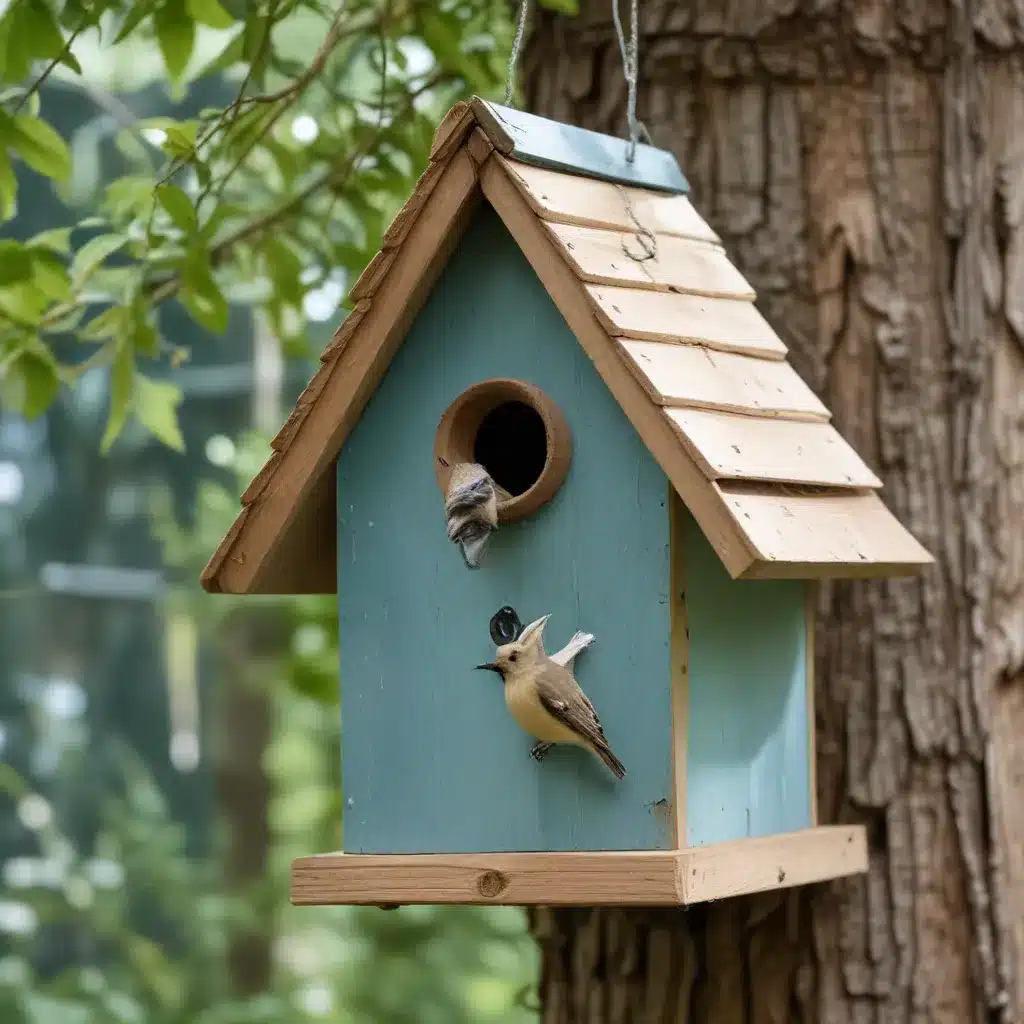
Birdhouse Blues: Addressing Common Safety Concerns in Backyard Habitats
As an experienced avian caretaker, I’ve seen it all when it comes to the joys and challenges of setting up safe, enriching backyard environments for our feathered friends. While the lure of watching colorful songbirds flit between homemade birdhouses is hard to resist, there are some critical safety considerations that every budding backyard birder should keep in mind.
Backyard Bird Shelters
One of the first steps in creating a bird-friendly oasis is providing appropriate nesting sites. Birdhouses are a popular solution, but their design and placement can make all the difference in ensuring the safety and success of their avian occupants.
Birdhouse Design and Construction
The key to an effective birdhouse is mimicking natural cavity nesting sites as closely as possible. Look for houses with 1-1.5 inch diameter entrance holes, 4-6 inch depth, and ample ventilation to prevent overheating. Roughened interior walls help chicks grip and climb. Avoid perches, as they allow unwanted visitors like starlings and sparrows to monopolize the space. Opt for durable, weatherproof materials like untreated wood, cedar, or recycled plastic.
Appropriate Placement of Birdhouses
Placement is just as important as the birdhouse itself. Situate houses 5-15 feet off the ground, away from high-traffic areas and shielded from prevailing winds and direct sunlight. Face the entrance hole away from windows to prevent collisions. Clustering multiple houses 25-50 feet apart can create a welcoming “neighborhood” for diverse species.
Maintenance and Cleaning of Birdhouses
Don’t forget regular upkeep. Clean out old nesting material each winter to discourage pests and disease. Disinfect with a weak bleach solution, let dry completely, and add a fresh layer of wood shavings or hay. Perform periodic inspections for structural damage or parasites. Timely maintenance keeps your backyard oasis in tip-top shape.
Threats to Backyard Birds
While birdhouses provide vital shelter, your backyard isn’t without its dangers. Vigilance is key to safeguarding feathered visitors from predators and other hazards.
Predator Avoidance Strategies
Domestic and feral cats are a major threat, snatching unsuspecting fledglings and nestlings. Keep cats indoors or install cat-proof fencing around nesting areas. Deter other predators like raccoons, snakes, and squirrels with baffles on pole-mounted feeders and houses. Prune vegetation to eliminate hiding spots near the ground.
Hazards Posed by Outdoor Structures
Backyard features like decks, sheds, and trellises can also pose entrapment risks. Seal any openings larger than 1 inch to prevent birds from getting stuck. Cover exhaust vents and dryer outlets, which can trap birds attempting to nest. Regularly inspect for nesting materials that could block airflow.
Minimizing Risks of Window Collisions
Window strikes are a leading cause of bird fatalities. Strategically placing feeders within 3 feet of windows, or far beyond 30 feet, can help birds perceive the glass barrier. Affixing decals, screens, or other visual markers can also deter collisions. Angling windows away from flight paths is another effective tactic.
Promoting Healthy Bird Populations
Providing abundant food, water, and cover are essential for supporting diverse, thriving backyard bird communities. With a little planning, you can create an oasis that meets all their needs.
Diverse Vegetation and Food Sources
Native plants are a bird’s best friend, offering nutrient-rich berries, seeds, and insects. Incorporate a variety of flowering, fruiting, and evergreen species to provide year-round sustenance. Supplement with well-placed feeders stocked with high-quality seed mixes, suet, and mealworms.
Water and Bathing Opportunities
Clean, reliable water sources are just as vital. Birdbaths, dripping faucets, and shallow dishes filled with pebbles encourage bathing and drinking. Position baths away from feeders to avoid contamination, and keep the water fresh and algae-free.
Reducing Human-Bird Conflicts
While we aim to create a bird-friendly haven, sometimes conflicts can arise. Proactive strategies can help mitigate issues before they escalate.
Managing Nuisance Bird Behaviors
Certain species, like pigeons or starlings, may become a nuisance by nesting in unwanted areas or causing property damage. Deter them with physical barriers, visual deterrents, or by removing food sources. Consult local wildlife authorities if the problem persists.
Ethical Bird Relocation Practices
In rare cases, you may need to relocate a bird, such as a fledgling in immediate danger. Resist the urge to “rescue” healthy young birds, as this often does more harm than good. Instead, contact a licensed wildlife rehabilitator who can properly assess the situation and provide expert care if needed.
Avian-Friendly Landscaping Practices
The plants, materials, and techniques you use in your backyard can have a profound impact on local bird populations. With a little research and planning, you can cultivate a sanctuary that supports avian life.
Incorporating Native Species
Native plants are a critical food source and nesting habitat for birds. Prioritize regionally appropriate species that provide nectar, berries, and shelter. Avoid introducing invasive ornamentals, which can outcompete native flora and disrupt delicate ecosystems.
Sustainable Gardening Techniques
Embrace organic, bird-friendly gardening practices. Minimize pesticide and herbicide use, which can poison birds and their insect prey. Instead, employ natural pest management and hand-weeding techniques. Opt for porous surfaces like gravel or mulch over solid pavement to support healthy soil ecosystems.
With a little planning and diligence, your backyard can become a safe, thriving haven for birds of all feathers. By addressing common safety concerns and promoting natural habitats, you’ll not only delight in the vibrant avian life, but also play a vital role in conserving local bird populations. Happy birding!


